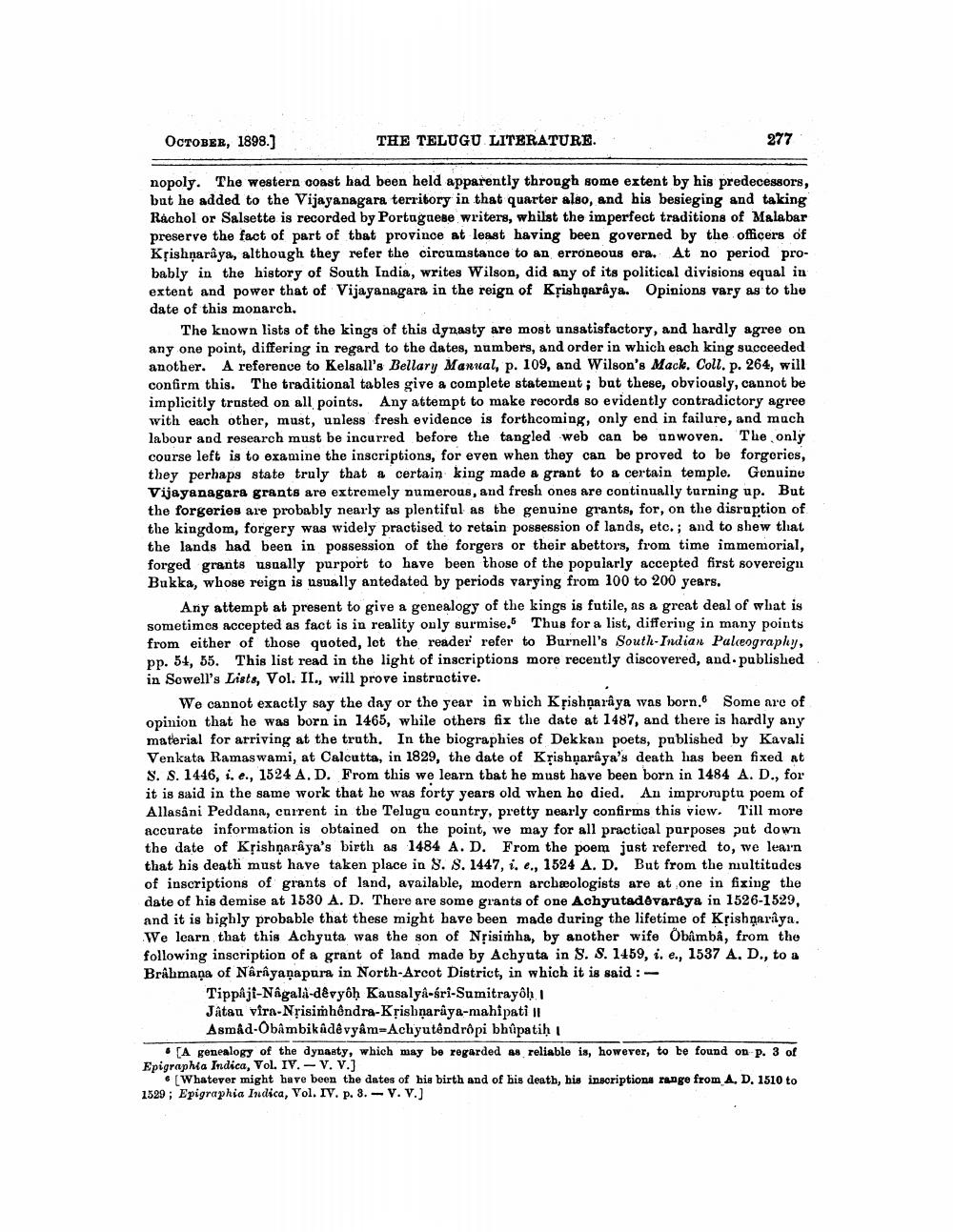________________
OCTOBER, 1898.)
THE TELUGU LITERATURE.
277
nopoly. The western coast had been held apparently through some extent by his predecessors, but he added to the Vijayanagara territory in that quarter also, and his besieging and taking Rachol or Salsette is recorded by Portuguese writers, whilst the imperfect traditions of Malabar preserve the fact of part of that province at least having been governed by the officers of Kțishnaraya, although they refer the circumstance to an erroneous era. At no period probably in the history of South India, writes Wilson, did any of its political divisions equal in extent and power that of Vijayanagara in the reign of Krishparâya. Opinions vary as to the date of this monarch.
The known lists of the kings of this dynasty are most ungatisfactory, and hardly agree on any one point, differing in regard to the dates, numbers, and order in which each king succeeded another. A reference to Kelsall's Bellary Manual, p. 109, and Wilson's Mack. Coll. p. 264, will confirm this. The traditional tables give a complete statement; but these, obviously, cannot be implicitly trusted on all points. Any attempt to make records so evidently contradictory agree with each other, must, unless fresh evidence is forthcoming, only end in failure, and much labour and research must be incurred before the tangled web can be unwoven. The only course left is to examine the inscriptions, for even when they can be proved to be forgeries, they perhaps state truly that a certain king made a grant to a certain temple. Genuine Vijayanagara grants are extremely numerous, and fresh ones are continually turning up. But the forgeries are probably nearly as plentiful as the genuine grants, for, on the disruption of the kingdom, forgery was widely practised to retain possession of lands, etc.; and to shew that the lands had been in possession of the forgers or their abettors, from time immemorial, forged grants usually purport to have been those of the popularly accepted first sovereign Bukka, whose reign is usually antedated by periods varying from 100 to 200 years.
Any attempt at present to give a genealogy of the kings is futile, as a great deal of what is sometimos accepted as fact is in reality only surmise. Thus for a list, differing in many points from either of those quoted, let the reader refer to Burnell's South Indian Paleography, pp. 54, 55. This list read in the light of inscriptions more recently discovered, and.published in Sewell's Lists, Vol. II., will prove instructive.
We cannot exactly say the day or the year in wbich Krishğaraya was born. Some nie of opinion that he was born in 1465, while others fix the date at 1487, and there is hardly any material for arriving at the truth. In the biographies of Dekkan poets, published by Kavali Venkata Ramaswami, at Calcutta, in 1829, the date of Krishqariya's death has been fixed at S. S. 1446, i.e., 1524 A. D. From this we learn that he must have been born in 1484 A. D., for it is said in the same work that he was forty years old when he died. An impromptu poem of Allasâni Peddana, current in the Telugu country, pretty nearly confirms this view. Till more accurate information is obtained on the point, we may for all practical purposes put down the date of Kțishnaraya's birth as 1484 A. D. From the poem just referred to, we learn that his death must have taken place in 8. 8. 1447, i. e., 1524 A. D. But from the multitudes of inscriptions of grants of land, available, modern archæologists are at one in fixing the date of his demise at 1530 A. D. There are some grants of one Achyutadevaraya in 1526-1529, and it is highly probable that these might bave been made during the lifetime of Krishnaraya. We learn that this Achyuta was the son of Nrisimha, by another wife Obîmbâ, from the following inscription of a grant of land made by Achyuta in S. S. 1459, i. e., 1537 A, D., to a Brahmaņa of Narayanapura in North-Arcot District, in which it is said :
Tippaji-Nagala-dêvyoh Kausalya-sri-Sumitrayôh Jatau vira-Nrisimhêndra-Krishnaraya-mahipati il
Asmåd-Obambikadêvyâm-Achyutêndrôpi bhûpatih • [A genealogy of the dynasty, which may be regarded as reliable is, however, to be found on-p. 3 of Epigraphia Indíca, Vol. IV. - V. V.)
Whatever might have been the dates of his birth and of his death, his inscriptions range from A. D. 1510 to 1529 ; Epigraphia Indica, Vol. IV. p. 3. - V. V.]




